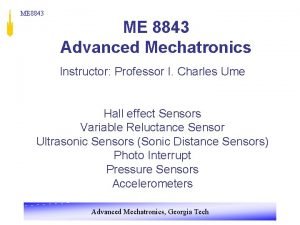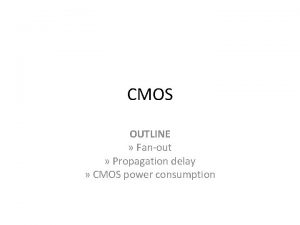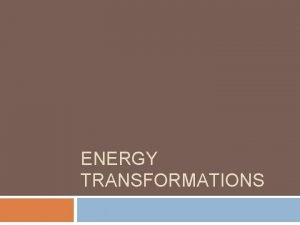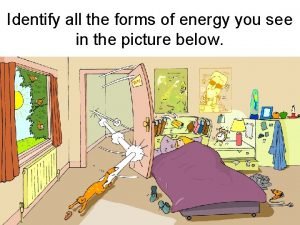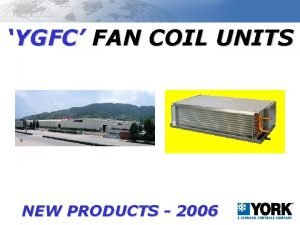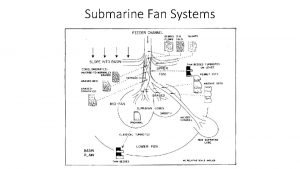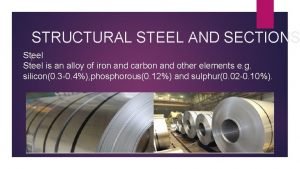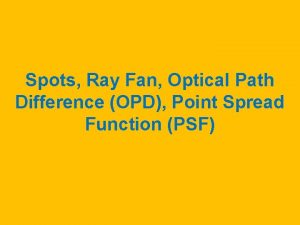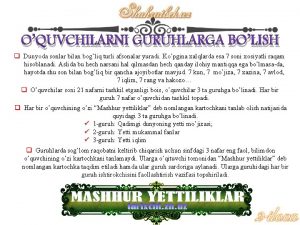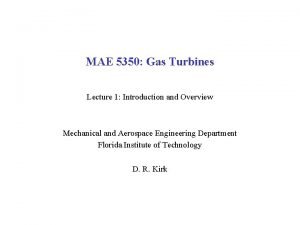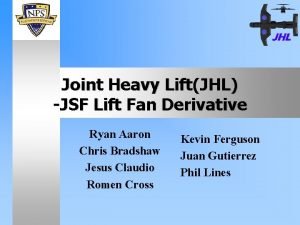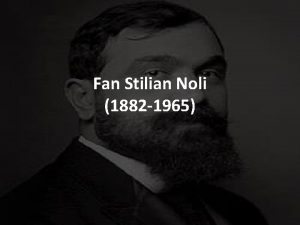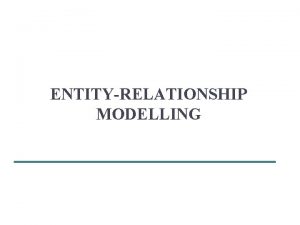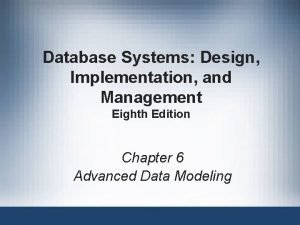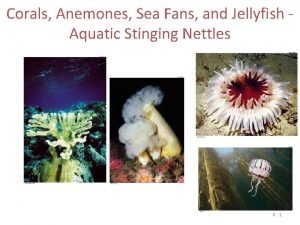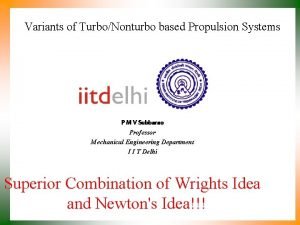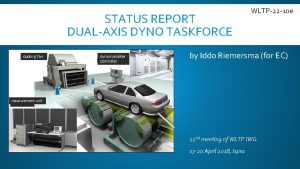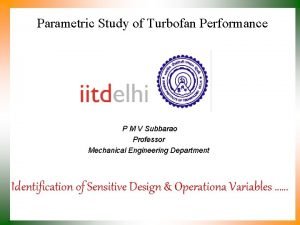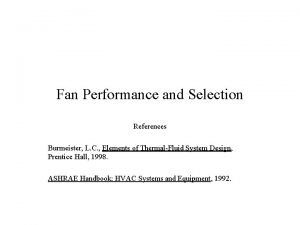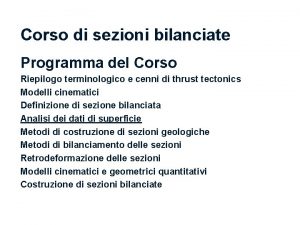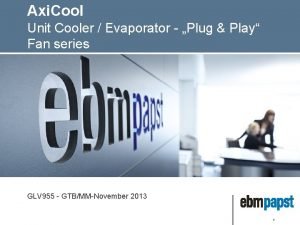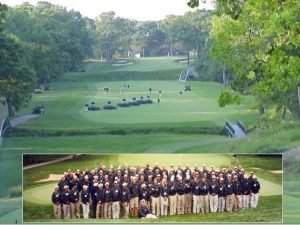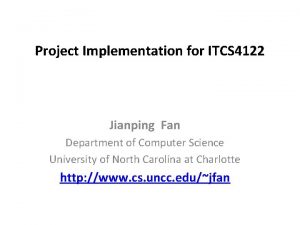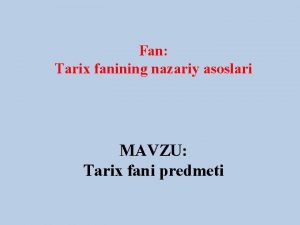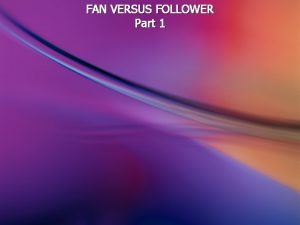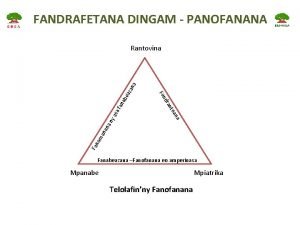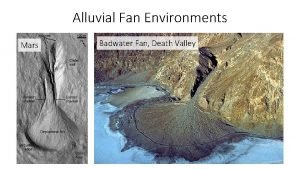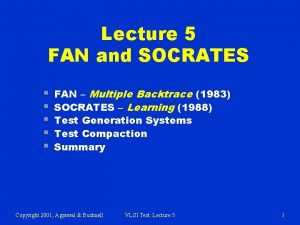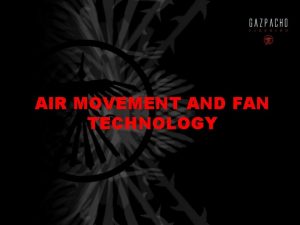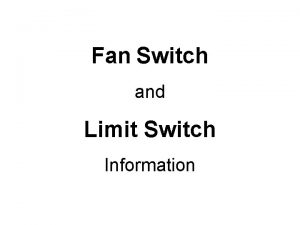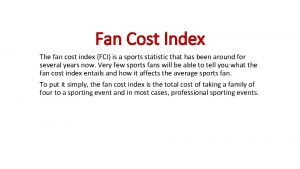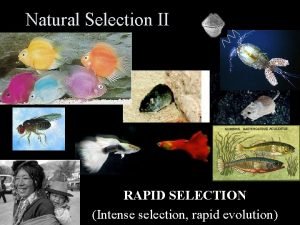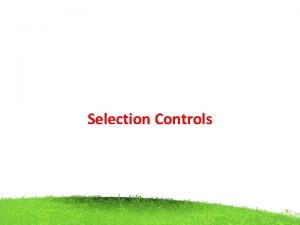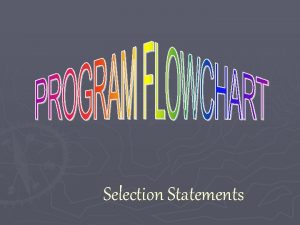Energy StandardsCodes Impact on Fan Selection April 2017





























































- Slides: 61

Energy Standards/Codes & Impact on Fan Selection April 2017 Mike Wolf, P. E. mike. wolf@greenheck. com

Learning Objectives • • Energy Legislation & Terminology Fan Energy Regulation Metrics Energy Code Fan System Requirements Elements of Fan System Energy – Personal Perspectives

Energy Legislation and Initiatives History & Trivia

What initiated energy legislation in the United States today? – Organization of Petroleum Exporting Countries(OPEC) Oil Embargo (1973) – 38 th President Gerald Ford (Republican) signed Energy Policy & Conservation Act of 1975 (EPCA) – US DOE established August 1977

What is a Quad? 5

1, 000, 000 BTU A Quad is*… 293, 297, 222 k. Wh 83, 333, 333 Tons of AC *Presenter is not responsible for conversions.

United States Annual Energy Consumption = 100 Quads 7

Background • According to the DOE U. S. fans consume: – 0. 9 quads of electricity in industrial applications – 1. 6 quads of electricity in commercial applications (2. 5 quads is about 2. 5% of total) * Sources: DOE and LLNL

Commercial Building Energy HVAC=40% Fans=15% (30%-40%) of HVAC California Commercial End-use Survey, prepared for CEC by Intron, Inc. , March 2006; CEC-400 -2006 -005

Fan Energy Consumption Power Input (Electrical) Power Loss ! Power Output (Flow and Pressure)

What is Fan Efficiency? Power Output Efficiency = Power Input CFM x Pressure Fan Efficiency = BHP

What is Fan Efficiency? CFM x P s Static Efficiency = x 100% 6343. 3 x BHP CFM x PT Total Efficiency = x 100% 6343. 3 x BHP PT = PS + PV

Fan Curves 6. 0 Ps 4. 0 BHP vs. CFM Surge Area 10. 0 8. 0 3. 0 6. 0 2. 0 4. 0 1. 0 2. 0 0 2 4 6 8 CFM x 1000 10 12 BHP Ps vs. CFM 5. 0

Fan Curves PT = PS + PV PT 5. 0 Total Efficiency PS 4. 0 100 80 3. 0 60 2. 0 40 1. 0 0. 0 20 Static Efficiency 0 2 4 6 8 CFM x 1000 10 12 0 Efficiency Pressure 6. 0

Fan Selection for Efficiency 6. 0 Ps Surge Area Ps 4. 0 High Efficiency, Low Sound BHP 3. 0 2 4 6 8 CFM x 1000 6. 0 2. 0 Low Efficiency, High Sound 0 8. 0 4. 0 Static Efficiency 1. 0 0. 0 10 12 0. 0 BHP 5. 0

Fan Performance vs. Fan Application % Ps Peak SE High Efficiency, Low Sound Actual Selections % CFM Static Efficiency

Fan Energy Regulation Metrics

Fan Energy Regulation Metrics 1. Standards/Codes (being adopted) – Fan Efficiency Grade (FEG) 2. Dept. of Energy (in development) – Fan Energy Index (FEI) 18

Fan Efficiency Grades • ANSI/AMCA Standard 205 -10 – Energy Efficiency Classifications for Fans • ISO 12759: 2010 Fans – Efficiency Classification for Fans


Fan Efficiency Grades AMCA 205 90 Peak Total Efficiency (%) FEG 90 Airfoil Centrifugal 80 FEG 85 FEG 80 Backward Inclined 70 FEG 75 FEG 71 FEG 67 FEG 63 Forward Curved 60 FEG 56 FEG 53 FEG 50 50 40 30 5 10 15 20 25 Fan Impeller Diameter (inches) 30 35 40

AMCA 205, Annex A: In order to achieve the goals in energy savings by operating fans it is important that the fan is selected in the system close to the peak of the fan efficiency. The fan operating efficiency at all intended operating point(s) shall not be less than 15 percentage points below the fan peak total efficiency (see figure).

Fan Efficiency Grades 6. 0 Ps vs. CFM 100 Peak 75% Ps 4. 0 3. 0 80 60 Total Efficiency vs. CFM 2. 0 40 1. 0 20 0. 0 0 0 2 4 6 8 CFM x 1000 10 12 Efficiency 5. 0

Fan Curves 60% Minimum within 15 points of peak efficiency Ps vs. CFM 5. 0 Ps 4. 0 3. 0 80 60 Total Efficiency vs. CFM 2. 0 100 40 1. 0 20 0. 0 0 0 2 4 6 8 CFM x 1000 10 12 Efficiency 6. 0

“Things are not always as they seem; the first appearance deceives many. ” - Phaedrus (Plato)

Fan Types 40, 000 CFM at 0. 25” Ps Model Impeller Dia BHP FEG $ Cost Sidewall Prop 54” 7. 11 56 1. 0 Tube Axial 54” 8. 30 67 1. 7 Vane Axial 54” 6. 87 75 4. 4 Housed Centrifugal 49” 13. 4 90 3. 8 Housed Centrifugal 60” 6. 8 90 6. 1

Fan Types Adhering to codes that require minimum fan efficiency grades will result in replacing this:

Fan Types With this:

Limitations of Fan Efficiency Grade (FEG) 1. FEG is an indicator of peak total efficiency 2. FEG NOT an indicator of fan input power 3. FEG is NOT a good comparison of fan power 4. FEG is LIMITED by fan type and horsepower 29

So what metric will the DOE use to regulate fan efficiency?

DOE Fan Energy Regulation • 31

Fan Energy Consumption Fan Power (at the shaft) Overall Fan Power (wire to air) Electrical Power In Motor Loss (10%) Drive Loss (3% -10%) Bearing Loss (3%) Aerodynamic Loss (10% to 20%) Fan Power Out

Overall Fan Energy Bearing Friction Loss V-Belt Friction Loss Power Output Aerodynamic Loss Motor Additional Electrical Motor Loss VFD Electrical Loss Input Power 33

Fan Efficiency Index (FEI) FEI varies along the fan curve Pressure 1. 0 FEI 0 Airflow Fan Efficiency Ratio - FEI 2. 0 Pressure

Fan Selections Narrow selection range around peak efficiency at high CFM and Ps Wide selection range at low CFM and Ps Allowable Selection Range

Fan Performance vs. Fan Application % Ps Peak SE High Efficiency, Low Sound Actual Selections % CFM Static Efficiency

What does this mean to Fan Selections? Multiple Speed Fan Performance Curves “Relatively High Efficiency Fan” – Large selection area Static Pressure Peak Efficiency FEI 1. 1 FEI 1. 0 FEI 1. 2 Airflow FEI 0. 9

What does this mean to Fan Selections? Electronic Fan Selection Software based on Total Pressure Design Point 10, 000 CFM at 3. 0” Pt Fan Size (in. ) Fan Speed (rpm) Fan Power (bhp) Actual Total Efficiency Baseline Power (bhp) Baseline Total Efficiency FEI 18 3238 11. 8 40. 1% 7. 96 59. 4% 0. 67 20 2561 9. 56 49. 5% 7. 96 59. 4% 0. 83 22 1983 8. 02 59. 0% 7. 96 59. 4% 0. 99 24 1579 6. 84 69. 1% 7. 96 59. 4% 1. 16 27 1289 6. 24 75. 8% 7. 96 59. 4% 1. 28 30 1033 5. 73 82. 5% 7. 96 59. 4% 1. 39 33 887 5. 67 83. 4% 7. 96 59. 4% 1. 40 36 778 6. 01 78. 7% 7. 96 59. 4% 1. 32

Product Case Study Design Point: 15, 000 CFM at 0. 5” Pt Fan Model Sq Inline 30” Sq Inline 42” Mixed Flow 27” EQB-27 30” Sq Inline Design BHP 5. 33 2. 92 2. 77 2. 83 FEI 0. 62 1. 18 1. 16 42” Sq Inline Oper Cost Weight Housing ($/year) (lbs) Width $1363 571 46” $758 735 58” $719 611 41” $734 451 41” 27” Mixed Flow Budget Payback Cost (years) $3300 1. 22 $4050 $6700 5. 28 $3900 0. 95 New Square Inline Fan with Improved Efficiency!!! New EQB-27 Lower Cost Mixed Flow Fan!!!

DOE Fan Energy Index - Applications How will FEI be used? Body FEI Requirement Federal Regulation FEI ≥ 1. 0 at Design Point ASHRAE 90. 1 FEI ≥ 1. 0 at Design Point ASHRAE 189. 1 FEI ≥ 1. 1 at Design Point Rebates FEI = Savings over Baseline FEI = 1. 10 means 10% energy savings over baseline 40

Benefits of Fan Energy Index(FEI) 1. FEI will limit fan power based on actual point of operation – (not the BEST point of operation) 2. FEI will drive energy savings 3. FEI can be used with all fans 4. FEI is a good comparison of relative energy consumption 5. FEI can be used to incent/rebate “stretch” metrics 41

Energy Codes

Energy Standard & Code Adoption “Base Standard” ASHRAE 90. 1 -2013 “Base Code” IECC - 2015 43

Federal Regulation Energy Standards/Codes State Energy Codes must: 1. Comply with ASHRAE 90. 1 - 2013 or equivalent and 2. Be Submitted to DOE by September 28, 2015 and 3. Be Adopted by September 26, 2016 https: //www. energycodes. gov/regulations/determinations 44

ASHRAE 90. 1 Adoption https: //www. energycodes. gov/status-state-energy-code-adoption ^ http: //www. iccsafe. org/wp-content/uploads/stateadoptions. pdf ^ http: //bcap-energy. org/code-status/commercial/

Energy Code Fan Requirements 46

ASHRAE 90. 1 -2013 6. 5. 3. 1 Fan System Power and Efficiency Limitation 6. 5. 3. 1. 3 Fan Efficiency. Fans shall have a Fan Efficiency Grade (FEG) of 67 or higher based on manufacturers’ certified data, as defined by AMCA 205. The total efficiency of the fan at the design point of operation shall be within 15 percentage points of the maximum total efficiency of the fan. Exceptions: a. Single fans with a motor of 5 hp (4 k. W) or less. b. Multiple fans in parallel or series that have a combined motor power of 5 hp (4 k. W) or less and are operated as the functional equivalent of a single fan. c. Fans that are part of equipment listed under 6. 4. 1. 1 Minimum Equipment Efficiencies – Listed Equipment – Standard Rating and Operating Conditions. d. Fans included in equipment bearing a third-party-certified seal for air or energy performance of the equipment package. e. Powered wall/roof ventilators (PRV) as defined by ANSI/AMCA-99 -2010. f. Fans outside the scope of AMCA 205 g. Fans that are intend to only operate during emergency conditions

6. 0 5. 0 4. 0 3. 0 2. 0 1. 0 0. 0 Ps vs. CFM 15 points of peak efficiency Total Efficiency vs. CFM Compliant Non. Compliant 0 2 4 6 8 CFM x 1000 10 12 100 80 60 40 20 0 Efficiency Ps ASHRAE 90. 1 -2013 Fan Curve

ASHRAE 90. 1 -2013 6. 5. 3. 1 Fan System Power and Efficiency Constant Volume Variable Volume HP<= CFM*0. 0011 HP<= CFM*0. 0015 e. CAPs Demo 49

ASHRAE 90. 1 -2013 6. 5. 3. 5 Fractional Horsepower Fan Motors for fans that are 1/12 hp or greater and less than 1 hp shall be electronically-commutated motors or shall have a minimum motor efficiency of 70% when rated in accordance with DOE 10 CFR 431. These motors shall also have the means to adjust motor speed for either balancing or remote control. Belt-drive fans may use sheave adjustments for airflow balancing in lieu of varying motor speed. Exceptions: 1. Motors in the airstream within fan-coils and terminal units that operate only when providing heating to the space served. 2. Motors installed in space conditioning equipment certified under Section 6. 4. 1 3. Motors covered by Table 10. 8 -4 or 50

Fractional Horsepower Motors • Single phase applications will require EC motors to meet efficiency requirements • Three phase applications may require VFDs to balance or for remote control • Take advantage of low cost speed control with VFD Integrated with Motor & Control 51

Elements of Fan System Energy (Personal Perspectives)

Elements of Fan “System” Power* Fan Design Fan Control/Sensors Fan Selection System Effect & System Leakage Air Distribution System Design & Components *Mike Wolf – Unscientific Estimates 53

Fan Selection to Minimize Energy SW Airfoil Centrifugal Fan Class Oper BHP COST 5 year TCO 22 III 24. 5 $4, 995 $26, 927 24 III 19. 0 $5, 113 $22, 122 27 II 16. 2 $3, 933 $18, 435 30 II 13. 6 $4, 170 $16, 345 33 I 12. 5 $4, 327 $15, 517 36 I 12. 0 $4, 995 $15, 737 Select Fans Based on Total Cost of Ownership Size 33 has the lowest TCO Fan Selection of 15, 000 CFM at 4” Ps 54

Fan Selection to Minimize Energy 18 Ps 20 22 24 27 30 • • Include Max Fan RPM on Equipment Schedule to Avoid Undersized Low Efficiency Fan Selections. Include Max Bhp on Equipment Schedule to assure compliance with Fan System Power limit in Energy Code Design Duty CFM

Air Distribution System Design & Components to Minimize Energy Design Pressure Loss – Varies Based on Components – e. g. ducts/dampers 56 e. CAPs Demo

System Effect & System Leakage to Minimize Energy Minimize System Effect e. CAPs Engineering Toolbox 57

Fan Controls & Sensors to Minimize Energy Avoid Overventilation w/ Variable Speed Controls Non-Invasive Airflow Monitoring Integrated Sensors & Speed Controls 58

Homework • • • Review what you have learned here. Share this info (FACTS) with your fellow consulting engineers, Architects, contractors, and end users, and code officials. Greenheck Product Application Guide, Understanding Fan Efficiency Grades – http: //www. greenheck. com/library/articles/88 • • Greenheck also has an FEG Energy Guide. Read more: http: //www. csemag. com – Search “FEG”

Reference Material • Introducing the Fan Energy Index; Air Movement and Control Association – https: //www. amca. org • HPAC Engineering Greenheck Product Update on U. S. Fan Energy-Efficiency Regulation – http: //hpac. com/iaq-ventilation/update-us-fan-energyefficiency-regulation 60

The mission of Greenheck is to be the market leader in the development, manufacture and worldwide sale of quality air moving, control and conditioning equipment with total commitment to customer service.
 Electrons flowing
Electrons flowing Propagation delay in cmos
Propagation delay in cmos Energy transformation oven
Energy transformation oven Identify the energy conversions in the illustration below
Identify the energy conversions in the illustration below Balancing selection vs stabilizing selection
Balancing selection vs stabilizing selection Artificial selection vs natural selection
Artificial selection vs natural selection K selected
K selected Natural selection vs artificial selection
Natural selection vs artificial selection Artificial selection vs natural selection
Artificial selection vs natural selection Disruptive selection
Disruptive selection K selection r selection
K selection r selection Natural selection vs artificial selection
Natural selection vs artificial selection Two way selection and multiway selection in c
Two way selection and multiway selection in c Two way selection and multiway selection in c
Two way selection and multiway selection in c Mass selection
Mass selection Energy energy transfer and general energy analysis
Energy energy transfer and general energy analysis Energy energy transfer and general energy analysis
Energy energy transfer and general energy analysis Tidal energy impact on environment
Tidal energy impact on environment Ygfc york
Ygfc york Submarine fan
Submarine fan What is structural steel made of
What is structural steel made of Opd fan
Opd fan Yetti mukammal fan
Yetti mukammal fan Psixologiya fanining predmeti va rivojlanish tarixi
Psixologiya fanining predmeti va rivojlanish tarixi Pedagogika tarixi fan sifatida eng qadimgi davrlardan
Pedagogika tarixi fan sifatida eng qadimgi davrlardan Anahaw fans
Anahaw fans Unducted fan engine
Unducted fan engine Contrary flexure turnout
Contrary flexure turnout Lift fan drive shaft
Lift fan drive shaft Fan ho
Fan ho Flywhisk meaning
Flywhisk meaning Fan stilian noli jeta dhe vepra
Fan stilian noli jeta dhe vepra Chasm trap
Chasm trap Roof truss connections
Roof truss connections Fan trap database
Fan trap database Cnidaria characteristic
Cnidaria characteristic Concept fan example
Concept fan example Conclusion of machine learning
Conclusion of machine learning Fast application notification
Fast application notification Fan pressure ratio
Fan pressure ratio Dyno cooling fan
Dyno cooling fan Tercet meaning
Tercet meaning Channel bar sungai
Channel bar sungai Wenfei fan
Wenfei fan Viessmann manufacturing company
Viessmann manufacturing company Fan pressure ratio
Fan pressure ratio Nexia charles mar fan limited
Nexia charles mar fan limited Esse fan noli
Esse fan noli Hung fan sing
Hung fan sing Gloria yang sex
Gloria yang sex Event.fan-pledge
Event.fan-pledge Fan law 1
Fan law 1 Fan xitao
Fan xitao Imbricate fan
Imbricate fan Are fan worms decomposers
Are fan worms decomposers Plug and play fan
Plug and play fan Fan spray nozzle
Fan spray nozzle Jianping fan
Jianping fan Kasbiy pedagogik fantaziya xayol
Kasbiy pedagogik fantaziya xayol Inncom e7
Inncom e7 Radiant floor heat exchanger
Radiant floor heat exchanger Maxsus tarix fanlari
Maxsus tarix fanlari
